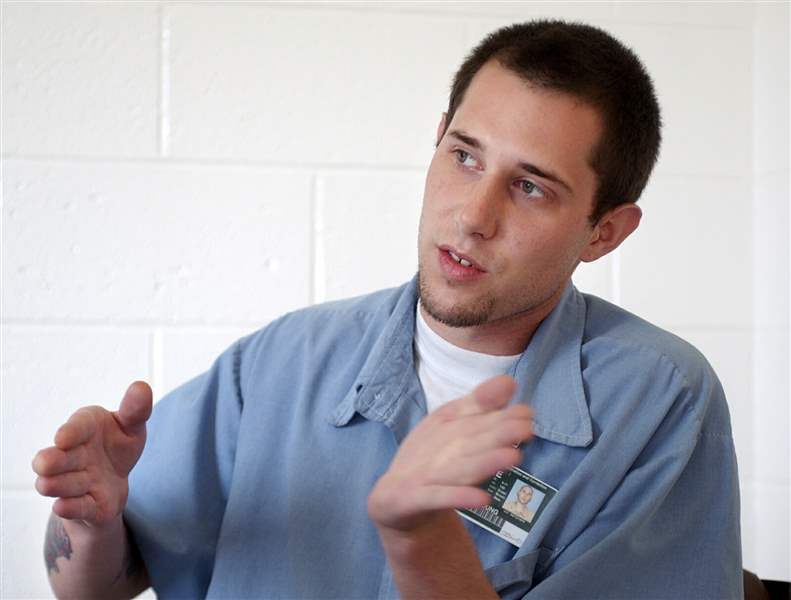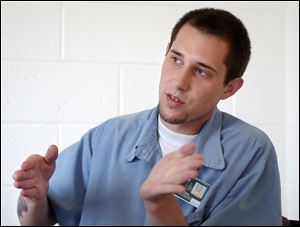
BEHIND THE CURVE: OHIO'S KILLER CORRIDORS
State Rt. 53 stretch has area's highest rate of fatalities
11/14/2004
Zachary Young recalls his drunk driving incident two years ago on State Route 53 that killed two of his friends. He is an inmate at the Mansfield Correctional Institution.
THE BLADE/DAVE ZAPOTOSKY
Buy This Image

Zachary Young recalls his drunk driving incident two years ago on State Route 53 that killed two of his friends. He is an inmate at the Mansfield Correctional Institution.
Zachary Young lay in a hospital bed -- intravenous tubes stuck in his arms, a brace strapped to his neck, an oxygen tube strung to his nose, and his mother standing beside him to deliver devastating news.
Two men were dead.
Young knew it was his fault.
The 23-year-old son of a retired sheriff's deputy had driven drunk the night before while ferrying four acquaintances to a bar. He ran a stop sign at State Rt. 53 in Ottawa County, and a pickup crumpled their car -- killing two of his passengers.
Young would recover and go to prison. The pickup driver -- himself drunk that night -- would go home and kill himself.
Three families would mourn what happened that night in a 2002 crash that's symbolic of a wider problem on the northwest Ohio portion of Route 53 -- a problem that's helped propel the route into a dubious distinction.
The route's stretch from south of Tiffin to the Lake Erie shoreline has the highest fatality rate of any major route in northwest Ohio, according to a computer analysis by The Blade. More notorious roads, such as U.S. 24, had more deaths, but their higher traffic load diluted their fatality rates.
And half of Route 53 deaths in northwest Ohio were crashes involving alcohol or drugs.
The safety struggles along Route 53 highlight a well-accepted belief in traffic-safety circles: Bad roads can't always be blamed on bad engineering. Often, poorly behaved drivers share the blame.
And there is no one particularly bad spot on Route 53.
The 14 fatal crashes from 1999 to 2003 occurred throughout the 45-mile stretch of highway from the Wyandot-Seneca county line to Catawba Island. That tally doesn't count the parts of Route 53 that piggy-back bigger routes, such as U.S. 20 and Route 2. The state attributes crashes on those segments to the bigger routes.
The crash factors also varied.

South of Tiffin, a sleepy pickup driver ran off the road, overcorrected, and died after slamming head-on into a car. Near Fort Seneca, a 19-year-old had a heart attack before drifting into the path of a pickup. South of Port Clinton, a toddler died after his mother skidded on ice and hit a tree .
But the biggest factor in many remaining crashes was driver impairment from alcohol or drugs. Six such crashes killed eight.
Among them:
- Near McCutchenville, a drunken driver rammed into a farmer's pickup. After the collision, as farmer Daniel Parker lay dying beside the road, the drunken driver sped off but was cornered in a nearby town by a trucker who witnessed the crash.
- At County Road 41 south of Fremont in 1999, an eastbound car sped past a stop sign and into the path of a northbound semi, killing's the car's 36-year-old drunken driver and his passenger, his father. Four years later at the same intersection, a westbound drunken driver high on marijuana sped past a stop sign into the path of a semi, killing himself and seriously injuring his passenger.
- Just north of the Ohio Turnpike, a drunken driver died after losing control of his nephew's car while rounding a curve at 95 mph. The nephew told police his uncle stole the car and allegedly was on his way to buy crack cocaine.
And in the case of Young, he left a party at a Catawba Island beach cottage with four acquaintances to go to a Port Clinton bar.
After a summer Saturday spent cooking bacon-wrapped steaks and drinking beer and shots, he remembers heading west on Twin Beach Road when a back seat passenger yelled that he wouldn't have time to stop. Then came a thundering boom as their BMW spun backwards over a berm and between two trees.
Young was flown by medical helicopter to Toledo, as was one of his passengers. Another passenger was sent to Port Clinton's Magruder Hospital.
Two other passengers, Quinn Hoffman and Mario Hernandez, were taken to the coroner's office.
A trooper took the other driver, David Molnar, to Magruder Hospital for a blood test. Even though he didn't cause the crash, Mr. Molnar was cited for drunken driving and possession of drug paraphernalia. The trooper later dropped him off at home with a summons to appear in court.
Mr. Molnar chose another fate: He shot himself in his home.
That morning, the Hoffman and Hernandez families began making funeral plans, and Young learned his actions the night before killed two acquaintances.
"It was a horrible feeling. It was just almost unbelievable," Young recalled from the Mansfield Correctional Institution, where he's serving 6 1/2 years for aggravated vehicular homicide. "It was just a real harsh sense of guilt."
Dale Jones, the president of the Toledo area chapter of Mothers Against Drunk Driving, said he's given plenty of talks to young adults in that area caught drinking and driving, and there's often a common theme: "[Route] 53 is always coming into play."
Lt. Brenda Collins, of the state patrol's Fremont post, said it's clear people are drinking near the lake and using Route 53 to get home. Troopers work 53 as best they can, including doing extra drunken-driving enforcement. But there's limitations on some things, such as checkpoints to look for drunken drivers.
To plan such sobriety checkpoints, the state looks for the most alcohol-related crashes per township, not per route. Even then, the patrol needs a safe place to pull off drivers, which is hard to find on two-lane routes like 53. Also, the patrol doesn't do such checkpoints within a mile or two of bars to avoid the appearance of targeting specific establishments.
Seneca County Sheriff Tom Steyer said he wishes he could boost enforcement, but his office averages 2 1/2 deputies per shift covering 550 square miles.
The Ohio Department of Transportation is spending $18 million to widen two miles from the Fremont bypass of U.S. 6/U.S. 20 to the Ohio Turnpike, and $4 to $5 million to upgrade the State Rt. 163 intersection.
Although both places are high-crash areas, neither hosted a fatal crash from 1999 through 2003.
Other states team up highway engineers, law enforcement, and others for sections of routes like 53.
In Washington state, the alcohol-related crashes on one notorious stretch were cut by nearly 60 percent.
While there weren't many engineering fixes, the team boosted enforcement and public awareness, as well as a unique approach: posting 6-foot-wide by 12-foot-high color photos of people killed by drunken drivers.
Ohio has no such program.
What's left are personal pleas of people like Young. Late at night in his small prison cell, he often ponders what happened on Route 53 two years ago.
"I hope people make better decisions in their lives."